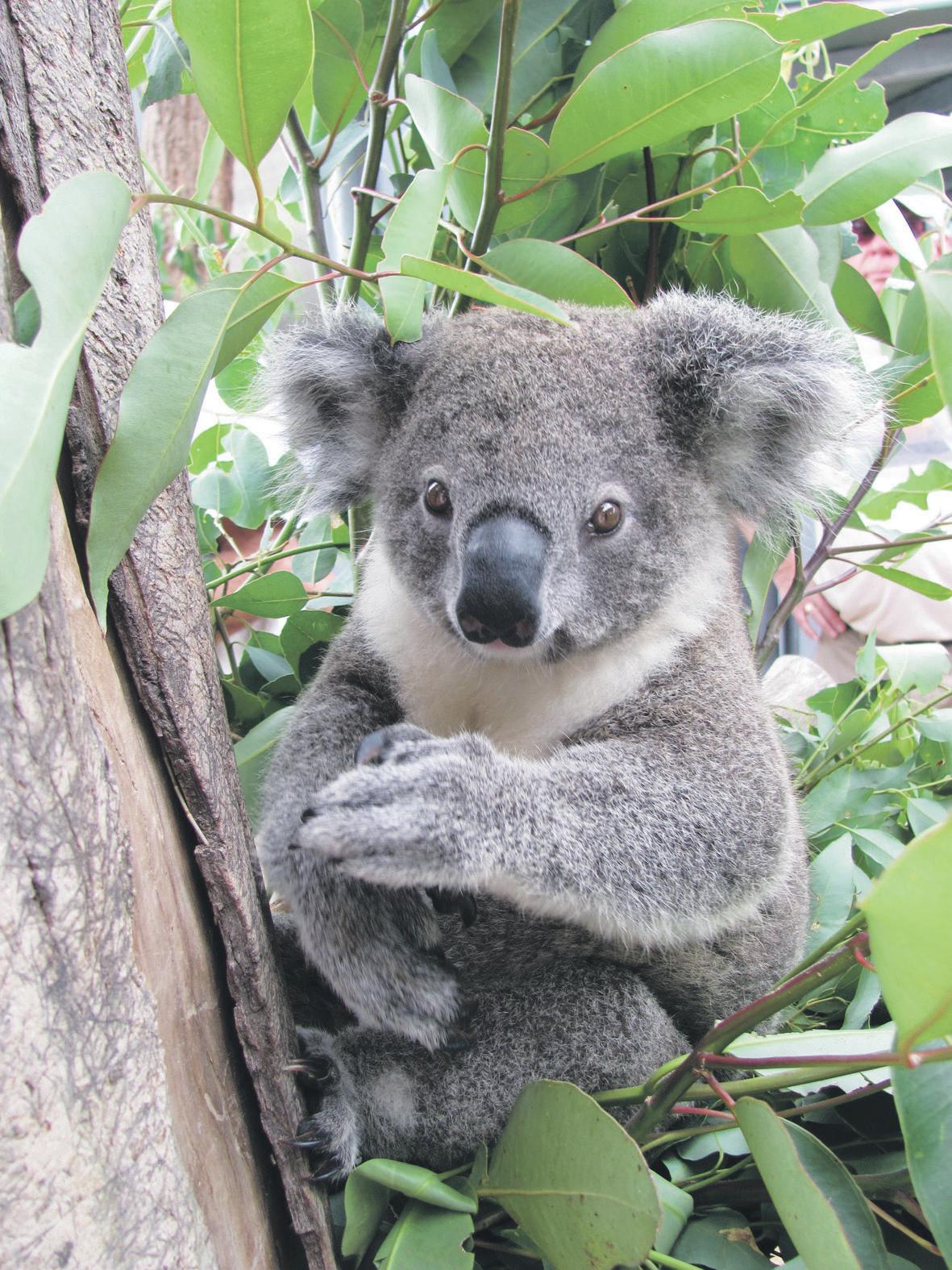
7 minute read
A walk with a view
from 2013-05 Sydney (2)
by Indian Link
The harbour foreshore on Sydney’s north shore is full of unspoilt bushland, secluded beaches and sweeping views defences, entering the harbour in May 1942.
The bushland along this walk, ranging from coastal heath and scrubland to woodland and forest, provides a habitat for native wildlife including water dragons, blue-tongued lizards, ring-tailed possums, kookaburras, rainbow lorikeets, currawongs, herons and dollar birds. Signs such as ‘Caution possums’ dot the roadside, and encounters with animals are not uncommon.

The walk to Chowder Bay begins at Taronga Zoo, which is well deserving of a separate visit, and onto Bradley’s Head, one of the most scenic sections of bushland that Sydney has to offer, named after Lieutenant William Bradley who landed here in 1788. There are several historic sites to explore including Athol Hall, with a large wedding reception in progress on the day I visited, and the HMAS Sydney memorial mast, one of the most distinguished Royal Australian Navy warships of World War I, as a tribute to those who served.
The walk continues to Clifton Gardens, named after TH Cliffe, captain of one of the American whaling ships, past beautiful angophoras or Sydney red gums with their curved, twisted trunks, the bushland maintained by local volunteers. Two of the original members, the late Bradley sisters, developed the method of bush regeneration that is still used across Australia today. Around a headland, Clifton Gardens Park is an idyllic setting for picnics, with an adventure playground and protected beach with a netted enclosure ideal for swimming and snorkelling, enabling a view the abundant marine life.
Just beyond is Chowder Bay, a cluster of historic buildings built in the 1890s for the Submarine Miners’ Corps, now operating as cafes, restaurants, a dive shop with scuba gear and kayaks for charming maritime village of historic buildings with an artist’s precinct and Frenchy’s café will greet you. The lookout provides a stunning vantage point with uninterrupted views across to Manly, Vaucluse and back to the city. Continuing along the bush track, a continuous line of metal stairs leads down to Balmoral, named after Balmoral Castle Aberdeenshire


The beachside promenade, esplanade, rotunda and Bather’s Pavilion, which date back to the 1930s, are heritage listed. The beach has splendid views to North Head and Clontarf
This is one of Sydney’s best urban walks, with vantage points overlooking the harbour and Pacific Ocean, well deserving of a visit.
One of Sydney’s newest parks, Headland Park straddles the ridgeline along Middle Head Peninsula, once home to Borogegal aboriginals who had lived there for thousands of years, fishing in the bays and
A wAlk with A view
TAR o NGA Zoo, C H o WDER B AY AND B ALM o RAL
INF o
Taronga Zoo is a pleasant, if somewhat exhausting full day excursion, that children especially will thoroughly enjoy. Entry is expensive, with a 15% discount for families. Worthwhile considering is the annual Zoo Friends Membership that provides unlimited entry throughout the year. A guided behind the scenes tour with a zoo keeper is a worthwhile additional expense. Open every day, take the Sky Safari from the wharf up to the main entrance then follow the winding pathways back down. Children love entering the native animal enclosure to view wallabies, echidnas and koalas.
T: (02) 9969 2777 W: zoo.nsw.gov.au

The Sydney Harbour Federation Trust was established by the Australian Government to preserve Sydney’s maritime and defence heritage and offers tours, open days, programs for children and downloadable maps of walks.


T: (02) 8969 2100 W: www.harbourtrust.gov.au
INSIDER ’S TIP
Water dragons usually scamper off, but if they are slow to move, give them time, as they have sharp claws. Signage is generally good.

G Etting There
I did the walk in one bite size chunk. While the time given is two hours, allow time to amble along. The most pleasant way to begin is by ferry from Wharf 2 Circular Quay to Taronga Zoo returning from Balmoral by bus. Buses are fairly infrequent. Trip planner: T: 131500 W: www.131500.com.au
If coming by car, access is via Middle Head Road, Mosman.
WHERE To EAT as East Pakistan, has undergone one of its most tumultuous years in its forty two year trials of Islamists accused of supporting the Pakistanis during the independence war, the country has since suffered the worst accident and has been Islamists demanding anti-blasphemy laws and exposed to a bit more excitement than he had bargained for. He wrote in an email that “it’s truly an overstimulating time to be here”. He also suggested that it was high time Australia Minister had visited for close to fifteen years. Late last year, I was involved in a television story about shipbreaking in Bangladesh, the visually extraordinary industry that recycles the material of old ships to be used in everything wiring. Its slave labour, unsafe practices and light touch regulation bear much resemblance to the country’s garments industry so under the
The area is well served by cafes and restaurants with more options in Balmoral or pack a picnic lunch.



I distinctly remember an image where a fleet whizzed by a dirt road, adjacent to a duck filled pond, where our crew shipbreakers bathing. Our fixer informed us that the motorcade shipyard, they were engaged in crisis control after a worker was critically injured. The nexus of the military, politics and business was an
This shady but ubiquitous overlap is best recounted by former navy administrator Dr , which tackles the secretive ten billion dollar empire of Pakistan’s military leaders, ranging intertwined by a shared religion, history and identity partially built in opposition towards organising principle is religion and the other language, both represent an important front in the struggle for secular humanism amid religious extremism. Australia’s interest in both has been lukewarm at best, overshadowed by its wooing of rising economic behemoth fastest growing region supplying migrants to our country, as measured by the last Census, the historical neglect may require review.
Australia is amongst the region’s highest aid donors, spending just under 100 million in both countries, representing the second highest donor as a representative of GDP.
Europe trapped in denial while India and Australia face reality
Sinking deeper into the mire of financial dissolution, Europe still struggles to face up to obvious realities unemployment and deepening frustration and anger, as witnessed by recurring demonstrations. Yet there is still a culture of denial.
BY NOEL G DE SOUZA
Europe is in the throes of denial at several levels while seeking to perpetuate a self-generated myth that all is well on the European front. Broadly speaking, the denial is that its austerity measures are successful and are working well. Instead, we see demonstrations and endless rounds of citizens battling with police. The fact that in several European countries a majority of young people are unable to get gainful employment, is a stricture on the situation. There are no signs of the supposed recovery in the southern European fringe between Portugal and Greece.
Another form of denial is that the norms of the colonial era still apply. This implies that Europe fixes the rules which have to be accepted by all those countries that were once subjected to their diktats (including China, India and the USA.) For example, Europe has unilaterally imposed a carbon emissions tax on planes flying to Europe. Retaliatory measures are being considered by affected countries, including India and the US.

Regarding carbon emissions, the Indian Prime Minister, concerned at the slow pace of moves to stabilise global temperatures, has blamed rich nations for causing global warming in the first place.
This is best articulated by Christine Lagarde, head of the International Monetary Fund (IMF). She speaks as if the Eurozone’s problems are on the way to being solved and as if the austerity measures have been accepted by its suffering populations. Ms Lagarde has had a distinguished career, having held several ministerial posts in France, including for finance and agriculture. She is at the forefront in supporting the Euro and the Eurozone austerities.
Lagarde says that currently a ‘three-speed’ recovery is going on with Europe, and contradicts herself by saying that Europe is suffering from incomplete policies and lack of demand for its products.
The trouble is that European leaders have never faced a situation like the current one. Their problems have their source in countries like China and India, where industrialisation is moving fast and efficiently.
Austerity measures, imposed from outside on troubled countries by the European Central Bank, have led to massive unemployment and deepening frustration and anger, as witnessed by recurring demonstrations
Another denial is that European civilisation will help the EU to overcome its economic hurdles. This was stated by the current Spanish Prime Minister, Mariano Rajoy, when he assumed office. It implies that the specialness and superiority of European civilisation which was a pillar of colonialism. Since he made that statement, the Spanish economic situation has worsened with over half of its youth unemployed.
“The whole history of European Monetary Union is of lawlessness based on political convenience,” says Oliver Hartwich, a commentator for Bloomberg. He adds that the rules of the Maastricht Treaty on which the Euro was based were not applied to the Maastricht Treaty attending countries, even though their debt loads were higher than 60% of their GDP’s.
The European Union is in trouble and several countries within the Eurozone are groaning under high debt and rising unemployment. The Cyprus crisis starkly brought this out with moves to virtually confiscate a percentage of hard-earned savings and the imposition of other austerity measures. The rest of the EU hardly blinked, as if the problem did not concern them.
Austerity measures, imposed from outside on troubled countries by the European Central Bank, have led to massive
Compared to the negative growth rates in many Eurozone countries, the World Bank predicts growth of 7.8% in East Asian and Pacific countries, which is up from last year. Others are not as optimistic, but even with some slowing down, growth rates are still expected to be positive.
While Europe has been running down its infrastructure, China has been building spectacular cities like Shanghai and designing and running incredibly fast trains. India has been also been creating new cities and transport systems. Recently, the Indian government has asked its states to select areas to develop industrial zones along with new cities.
The fundamental reason why the European Union was formed seems to have got lost because of the Eurozone crisis. The EU was formed to end the countless wars which plagued Europe in the last two centuries. Neighbouring countries fought ruthlessly with each other and the result was a Europe ruined and exhausted. It was the American Marshall plan that helped to get Europe back on its feet.
The only plan which currently exists to bring economic order to Europe is the austerities plan for the Eurozone nations. Similar, though not identical austerities, are in the offing for Australia which is in a much better economic situation than Europe.
The European Union has had its reputation and its usefulness so tarnished, that an influential Tory group in Britain is talking of quitting the EU or at least renegotiating its terms of membership. These include Lord Lawson and former cabinet minister Michael Portillo.













